I was quite excited when I heard that the University of PEI was holding an open house today: I’m something of an open house junkie, and I love the combination of “backstage access,” education and fun that a good open house brings together.
And we’ve some good open houses here on PEI: CBC Prince Edward Island always puts on a good one, and who can forget the opportunity to see the amazing envelope-opening machines at the GST Centre’s open house many years ago when it first opened.
The Atlantic Veterinary College is well-known for it’s extremely well-organized open houses, and I welcomed the opportunity to learn about the rest of UPEI’s activities in the same manor.
And so, after our usual Saturday morning trip to the Charlottetown Farmer’s Market, [[Oliver]] and I headed across the street to UPEI, primed and ready for action.
With memories of an unfortunate goat incident still fresh in my mind from the last Vet College open house, I decided it was probably best to start elsewhere, so we headed over to the shiny new business school ready to see what delights were on offer.
Alas there were none: we found some sort of conference going on, but no evidence at all of open house-related activities.
Okay, so no business school. But science is cool. So we walked over to the chemistry building. Nothing. The Cass Science Hall. Nothing.
Things were not looking up, so I decided we’d better head to the Vet College.
And, true to form, they put on a great event: everything from a handshake and welcome by the Dean at the front door onwards was well-organized, entertaining and educational. We saw living animals and dead animals and a horse treadmill and a snake skeleton. Oliver got dressed up in surgical garb and won a pencil in the fish pond. We learned about parasites and bacteria. And there was even a magic show.
With our spirits renewed by our veterinary successes, we headed back out onto the campus, sure that there must be something to see.
First stop: the School of Nursing. We followed a friendly chap who was hanging up the signs around the corner and up the path: “just go down the stairs and you’ll find them,” he told us.
We went down the stairs. Nothing. Wandered through the halls. Nothing. Finally, at the end of the end of the building we found an open door: the open house!
While I wish I could report that we emerged newly educated about the nursing profession and its educational process, what we encountered was the opportunity to be shown a non-working medical dummy and a drawer full of supplies. The nursing student who took us on this tiny tour was friendly enough, and answered all our questions, but there was, literally, nothing at all to see.
The only other open house activity on the signs was at the Robertson Library; knowing all the amazing things that the library is up to, I was excited by the prospects of what might be in store there.
And while there was slightly more energy in evidence in the library – well-meaning librarians singing songs and offering cookies and juice – the lost opportunity to showcase all of the library’s amazing projects was tragic. Where was the tour of the language lab? The demonstrations of the book, map and newspaper scanning equipment? A hands-on workshop in the Collaboratory? All these doors, alas, were left un-opened.
And that was it.
An entire university full of fascinating people doing fascinating things, and, aside from the vets, all we were exposed to was a hospital bed and a rousing rendition of a nursery rhyme.
If the University of PEI is sincere in its mission to, as President Wade MacLauchlan suggested, “find the time to tell each other and the world about what we are doing and achieving,” then they have to do better than this.
Open houses, done well, take a lot of effort by a lot of people. They take resources and time and energy and imagination. But UPEI has a head start: the vet college’s yearly open house is a showcase for how to do open houses well, and the rest of the university community needs to follow that lead and start thinking about how to tell their own stories to the “university island” that surrounds them.
No, the philosophy department doesn’t have cute puppies and pig bladders on its side. But it does have interesting, creative people, skilled at story telling and making sense out of arcane and complex ideas. And that’s all you need to open your doors.
Next time out UPEI needs to either scale back and do what it does well at the AVC, or take this open house idea seriously and make a real effort to open the house.
With Municipal Elections coming up in Charlottetown, Cornwall, Stratford and Summerside this fall, we’ve spent some time renovating the Municipal Elections section of the Elections PEI website. What once was a rabbit’s warren of various pages hung on various URL schemes has been consolidated into a well-organized and comprehensive set of pages that offer access to all of the data on each municipality that Elections PEI maintains.
For example, on Municipalities page you’ll find a list of all 75 municipalities on the Island.
Click any municipality – say, Souris – and you’ll see contact information and a map of municipal boundaries and, for the four municipalities for which Elections PEI conducts elections – like Charlottetown – and you’ll see a list of wards and a ward boundaries map.
And so on: look at a ward, like Queens Square, and you see a list of polls and a poll boundaries map; look at a poll, like Hensley Street, and you’ll see a map of the poll along with information on where to vote and how to contact the returning officer.
All of this arrange in a friendly set of increasingly-more-specific URLs:
- http://www.electionspei.ca/municipalities
- http://www.electionspei.ca/municipalities/charlottetown
- http://www.electionspei.ca/municipalities/charlottetown/ward1
- http://www.electionspei.ca/municipalities/charlottetown/ward1/poll2
All of the maps referenced by these pages are available in KML form and the “master” maps of boundaries are available in ESRI Shapefile format.
The really neat thing (at least if you’re a programmer or developer) is that you can stick an “xml” in those URLs and get exactly the same information in XML format:
- http://www.electionspei.ca/xml/municipalities
- http://www.electionspei.ca/xml/municipalities/charlottetown
- http://www.electionspei.ca/xml/municipalities/charlottetown/ward1
- http://www.electionspei.ca/xml/municipalities/charlottetown/ward1/poll2
This means that citizens now have “programmatic access” to municipality information. Meaning that if you want to develop an iPhone application lists polling station locations, or a maps mashup that uses polling division boundaries, you’ll now have all the data you need.
This is a work-in-progress; watch electionspei.ca/api for documentation and information about changes and extensions.
On Saturday afternoon [[Oliver]] asked me for some help getting Google SketchUp installed on his computer. He needed to do some building design work, and he’d decided that SketchUp was the tool for the job.
We got the program installed, watched the New to Google SketchUp tutorial video together, and then I ran through a couple of other features with him, like how to import other people’s creations from the 3D Warehouse.
Then he was on his own.
When I came back a few hours later he’d constructed a hotel-spa-restaurant-radio station complex of considerable complexity. Such is both the simplicity of SketchUp and the power of Oliver’s iterative learning style.
This morning Oliver woke me up at 7:00 a.m. and asked how he could retrieve the files he’d saved on the weekend and I told him about File | Open Recent and went back to sleep.
When I rumbled downstairs an hour later for the walk up to school, Oliver was in quite a state, having decided that he would rather stay home all day continuing to refine his buildings – he told me later he was working on a model of his school – and it took all of our parental superpowers – “hey, isn’t it gym day today!” – to retrieve a mood sufficient to normal routine to proceed.
And there’s the conundrum.
Oliver’s now at school, which he generally enjoys, and is likely immersed in some sort of project carefully designed by his teachers to artificially stimulate his interest. This will likely succeed to some degree, as Oliver likes learning and is generally a pliable child.
But no matter what heights of educational greatness they manage to achieve at the school, they will, I’m sure, fail to reach the place that Oliver was at this morning at 8:00 a.m. when all he wanted to do was design a building.
We parents can rationalize ripping him away from this with high-minded broad strokes about how kids need to “learn to follow a routine” and that they “can’t always do what they want” (read “look, I gotta go to work and I can’t look after you all day”).
But it still seems like a failure and like a part of a larger plan to inculcate Oliver in a system that is designed to train him to dampen his passions and disconnect learning from curiousity.
How did we get here?
Episode 120 of Spark, wherein I discuss the ins and outs of printing ebooks with Nora Young, has just hit the Internet. You can listen to it online right now. Or, if you prefer, on your radio on Sunday, September 19th at 1:00 p.m. Atlantic (times may vary in your time zone; check the schedule) on CBC Radio One.
If you’re really keen, you can listen to the entire uncut interview (the one with all the swearing and gratuitous violence left in).
It has been brought to my attention, through intermediaries, that some senior members of the readership have come to feel that this weblog has become “all letterpress, all the time.” Sarcastic comments to this effect may have even been made.
While my initial reaction to hearing this was to mutter “well then, damn them all to hell,” and to install a 301 redirect to, say, TMZ.com, upon reflection I realize that there is some truth to this.
And so while I will resist suggestions to “go and set up a separate letterpress blog,” I will endeavour to inject more of the witty commentary about life’s foibles that you’ve come to expect here. And so, to that end, here are condensed version of the five posts I didn’t write this summer because I was too busy obsessing about Bodoni.
Meet the Staff Night
It was “Meet the Staff” night at Prince Street School last night (a wise re-naming from “Meet the Teacher,” as only 12 of the 40 people employed at the school are classroom teachers). Attendance was great: the gym was packed for the information session that started the night, and the halls were bustling for the classroom visits.
Truth be told, though, while we parents can, indeed, “meet the staff,” there’s not actually much opportunity for parent-teacher dialogue at this event: hard to discuss your child’s particular eccentricities while there are other parents and children milling about. It’s really more of an “open house” than a “parent-teacher conference.” Still a valuable exercise, though, if only because we parents get to meet each other, which makes morning drop-off and afternoon pick-up a more social time.
There remains a language barrier, however: two of the other fathers in Oliver’s class, for example, speak very little English, and so their back-and-forth with the teacher was limited to hello and good-bye and pointing out their homeland on a map; I hope to work with the Home and School to improve availability of translators for events like this to ensure that all parents have an equal opportunity to participate.
Hairspray
The musical Hairspray, now playing at the Confederation Centre of the Arts, seems to be on track for “rousing success” status. Certainly Catherine and Oliver enjoyed it when they attended the opening night performance.
While I understand something of the financial rationale for producing shows like this, it pains me to see the Centre’s playbill gravitating toward more “popular” fare as the years go on.
Not to suggest that the Centre should endeavour to product unpopular entertainment, but it’s getting increasingly difficult to see how shows like this help to fulfil the mandate of the Centre to be Canada’s National Memorial to the Fathers of Confederation.
When Prime Minister Lester B. Pearson spoke of “fostering of those things that enrich the mind and delight the heart, those intangible but precious things that give meaning to a society and help create from it a civilization and a culture” surely he wasn’t referring to shows like Hairspray, was he?
It’s not that Hairspray and its ilk are bad – they employ local musicians and artists and actors, they bring in dollars that support the Centre’s other activities, they bring people downtown into restaurants and bars – it’s just that it’s hard not to imagine what their presence on the calendar is replacing: if the Centre can mount a compelling musical about 1960s Baltimore, surely it can equally as well mount a compelling musical about, say, the Johns Hamilton Gray.
PEI Flavours
Here on the Island we’re now deep inside the calendar of events related to the Fall Flavours Festival and its season-long mothership PEI Flavours.
Both are laudable efforts – who can argue with tourism promotion that seeks to include the primary industries and encourages people to eat in restaurants and visit farms – but both efforts seem blind to an entire cross-section of the culinary landscape on PEI, the restaurants, many of them new in the last decade, clustered in Charlottetown, that broaden the palette of what “PEI flavours” can mean.
Within 5 minutes walk of where I write in downtown Charlottetown, for example, there are seven restaurants serving sushi, two restaurants serving Thai food, four Taiwanese tea rooms, a patisserie serving pan-European pastries, at least four places where I can get a very good shawarma sandwich.
While the food served in these restaurants is not “traditionally Prince Edward Island” – although it would be hard to argue this in the case of the shawarma, which has been a part of the Charlottetown culinary landscape for generations – it’s all food prepared by Islanders, much of it using the same local ingredients that are used in the restaurants that PEI Flavours does highlight.
It’s possible to spend an entirely satisfying week in Charlottetown without a lobster, potato or mussel touching your dinner plate, and that’s something that we should not only be proud of, but that we need to embrace, promote, and include in our collective definition of what “Island food” means.
Sound and Light Show (with less sound)
Last year saw the introduction of a sound and light show projected on Province House every summer night. And last year’s incarnation of this show placed a significant dent in the quality of life in our Queens Square neighbourhood: you could sit in our living room during the show and it was as if there was a 4 foot speaker blaring the sound from the show into our house.
This was not only an annoyance, but also caused “getting Oliver to bed” issues for us, as the sound echoed right into the window of his bedroom and the back of our house.
After I failed to get any response to complaints about this problem from Tourism Charlottetown and the City, I brought my concerns to the attention of Parks Canada, which manages Province House and, I reasoned, must be the ultimate authority on the issue.
I don’t know how and through whose good graces, but I’m happy to report that this season the problem has been non-existent: despite that sounds, when you’re standing in front of Province House, to be a mighty and booming PA, by the time you walk over to 100 Prince Street it’s but a whisper, and so the issue has ceased to be an issue at all.
So, whoever you are the the tourismocracy that switched whatever switches needed to be switched or repointed whatever speakers needed to be repointed, thank-you.
Island Newspapers
Longtime readers may recall the talk Working for Free that I presented at the reboot conference in Copenhagen in 2008. On of the “working for free” projects I talked about was the idea, first raised at a casual lunchtime conversation with Mark Leggott, new Librarian at the University of PEI, about digitizing the archive of The Guardian newspaper, a project represented in the talk like this:
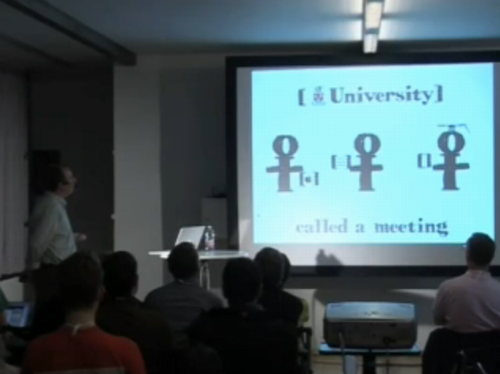
I’m happy to report that this effort is well-underway now, and you can see early results at IslandNewspapers.ca. There are only 137 issues of The Guardian online there now, and there’s obviously some usability and design work to be done to make the resource truly useful, but what’s there is enough to show the huge potential this project has to transform Island history research. Bravo to Mark and his staff for pushing forward on this.
From the Port Explorer for Charlottetown from Celebrity Cruises:
USEFUL WORDS AND PHRASES English and French are the official languages of Canada. English speaking Canadians might use other words than Americans for certain things. Some examples include:
Canadian English - American English
pop - soda
chemist - pharmacy
boot - trunk of a car
chips - French fries
Only one of these, in my experience, is accurate.
The Celebrity Summit docks in Charlottetown for the first time next Thursday, September 23 at 8:00 a.m. with 2,100 passengers aboard. Through the generous arrangements of local travel agent Tracey Allen I’m actually due to have lunch on the ship.
If you’re anything like me, you’ve got a collection of Twitter robots, written in various languages, the push automated tweets for applications like @city_cinema and @casamiacafe using code that looks like this:
curl -s \
-d 'status="Movie tonight!' \
'http://city_cinema:XXXXXXX@twitter.com/statuses/update.xml'
And you probably noticed, despite months of warning, that your applications just up and stopped working on September 1, 2010 because of Twitter dropping support for Basic Authentication.
And so you went and read all about OAuth and grabbed an OAuth library and tried to make your way through the thicket of conceptual leaps required to grok the new way of doing things.
And then you threw up your hands and cried “but all I want to do is tweet!”.
When you get to this stage, here’s what you need to do (at least if you speak PHP):
1. Install the PECL oath package:
pecl install oauth
2. Go to the Twitter Developer site and register a new application. This will feel strange to you – “I just want tweet!” – but you must do it. You’ll need to set the “Callback URL“ to something, but as you’ll never actually use this, it can be anything.
3. Once you’ve added your new application, on its “Application Details” page you’ll find Consumer key and your Consumer secret; you’ll need these in a moment.
4. On the application’s “My Access Token” page you’ll find your Access Token and Access Token Secret; you’ll need these too.
You now have everything you need to tweet. Here’s the PHP you need to tweet it with:
<?php
$status = "Look, I'm tweeting from PHP!";
$consumer_key = 'XXXXXXXXXXXXXXXX';
$consumer_secret = 'XXXXXXXXXXXXXXXX';
$access_token = 'XXXXXXXXXXXXXXXX';
$access_token_secret = 'XXXXXXXXXXXXXXXX';
$oa = new OAuth($consumer_key,$consumer_secret,
OAUTH_SIG_METHOD_HMACSHA1,
OAUTH_AUTH_TYPE_URI);
$oa ->setToken($access_token, $access_token_secret);
$oa->fetch("https://twitter.com/statuses/update.json",
array("status" => $status), OAUTH_HTTP_METHOD_POST);
?>
Of course this can be all prettied up and turned into a PHP class, and have error testing built in, but that’s the heart of it there.
After a lot of detailed futzing around – setting the type, justifying the type, proofing, correcting, proofing, aligning the bed of the press, adding a heading – here’s the latest print of the first sentence of Anne of Green Gables I created today:
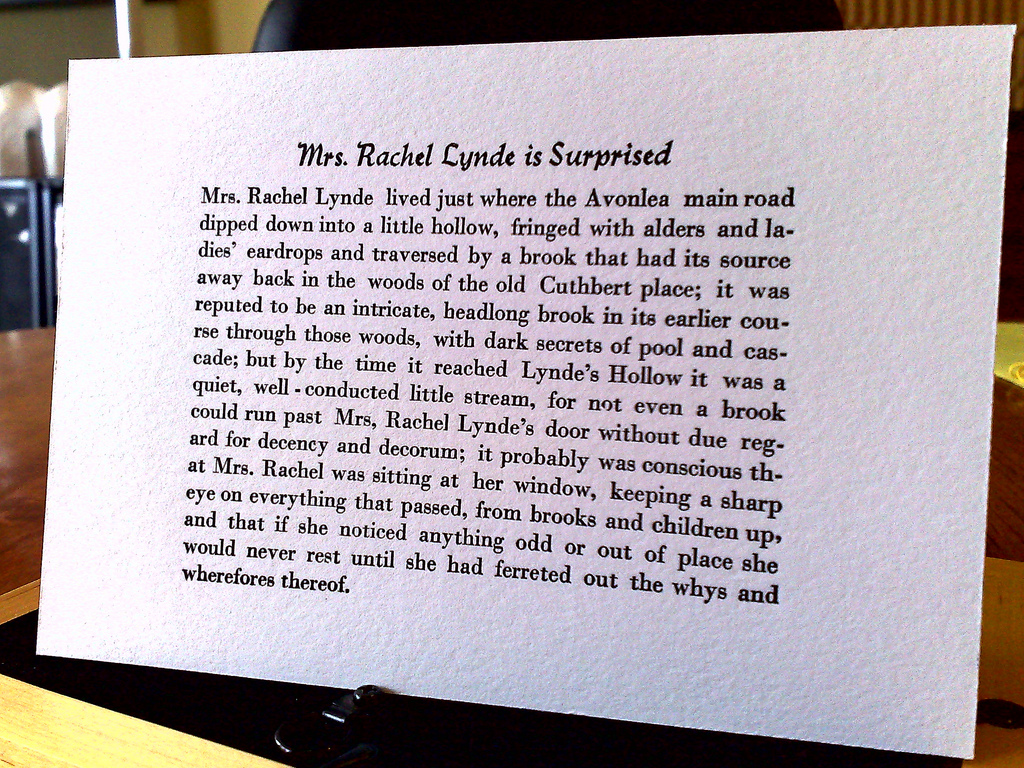
It’s printed in 12 pt. Bodoni on Crane LETTRA Fluorescent White 220 lb. cover stock, part of a sample pack I ordered from Neenah Paper. I ever-so-slightly dampened the paper before printing – I spritzed some water from an old Windex sprayer into the air and wafted the paper through the mist. Here’s what it looks like up close:
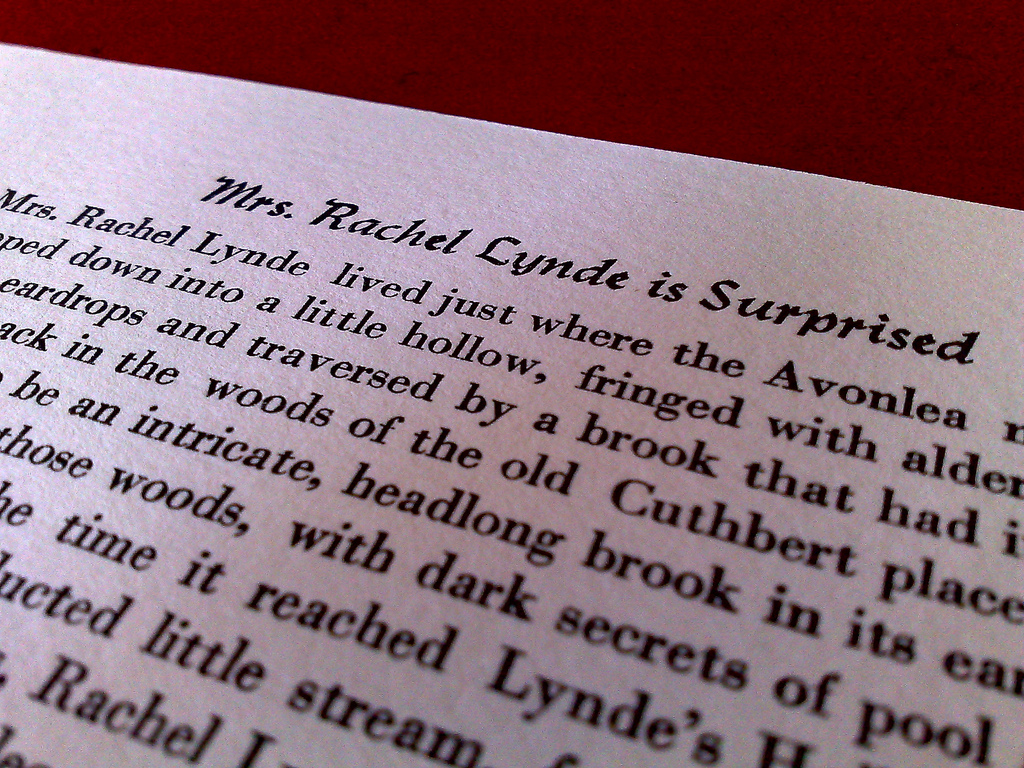
I’ve very happy with the way this turned out: I learned an awful lot about letterpress in the process of creating it. And while there’s a lot of room for improvement – to start, I need to learn a lot more about justifying type – that this print came out of a press that just a few months ago was caked with decades of ink and grime, and that I had no idea of the workings of, seems like a minor miracle.
I must admit to complete ignorance of fashion (no doubt you already know this if we’ve ever met in person). When I last paid attention, “rugby pants” were all the rage. I’m still trying to figure out what culottes are. And spaghetti straps?
Here are the rules at Oliver’s school for what students and staff are not allowed to wear:
- Straps must be at least two fingers wide. No spaghetti straps.
- Full length shirts - no low cuts and no belly shirts.
- Shirts must not have sexual comments or inappropriate logos or graphics (ie. alcohol).
- Shorts and skirts need to be at least finger-tip length, when arms are beside the body.
I’m fascinated by lists like this because they seem so arbitrary. And so rooted in the 19th century conception of what’s proper.
It’s not that I’m necessarily opposed to the notion of regulating dress (although the more anarchistic parts of my brain are strongly so, I must admit). It’s just that if you’re going to regulate dress, why not do it with some moxie. Here’s what the rules at Pete’s Academy would be:
- No corporate logos on anything. At all.
- On Wednesday everybody has to wear a tie.
- No velcro shoes allowed.
- Dress shirts, if worn, must have button-down collars and be at least 90% cotton.
- Socks must be worn at all times, and must be lime green, purple, yellow or fuchsia in colour.
- If worn, t-shirts must be printed with slogans that express a strong point of view. About something.
- Yellow rain coats only; no green, no blue.
Back in the mid-1980s when I found myself bored with public school I flirted with the notion of going to Hillfield Strathallan College in Hamilton. While there were plenty of reasons to not do this – I flunked the “religious knowledge” part of the entrance exam, for example; and then there was the whole “cultural snobbery” thing – what pushed me over the edge was the school uniform. The day I attended the school open house happened to be the day of the switch from winter uniforms to spring uniforms, and the reaction of the students to this news – elation would not be too strong a word – told me all I needed to know.
Here’s the dress code at Hillfield Strathallan these days:
Proper school dress is a requirement for attendance and to encourage students to be known and recognized for who they are. It is the responsibility of the students and parents to know what the dress code rules are and to abide by them. If there are parental concerns regarding the suitability of an article of clothing, it is best to inquire of the Principal before the article is purchased and worn, to eliminate unnecessary expense, and to allow replacement of the article, if necessary.
The College standard of acceptable dress is defined
as follows:all clothing must conform to College regulations
it must be clean and in good repair
it must be worn properly as outlined by the PrincipalStudents wearing temporary improper variations of the uniform must have an explanatory note from a parent and the approval of the Principal before attending class. Dress infractions are dealt with by each school under the supervision of the Principal.
School uniforms are required for all students during school hours, for special College occasions and by team members representing the school. Sweaters (Mondays) and blazers (Fridays) must be worn at Chapel except during the ‘summer dress’ seasons in early fall and late spring.
They are to be worn at lunch unless announced otherwise. Uniforms are not required for spectators at games in the evenings or on weekends. The beginning/end of winter dress times will be announced to the students.
Only new College and House ties are acceptable and student blazers, sweaters, polo shirts and golf shirts must feature the new HSC crest (shield and mottos).
Please note that ‘heely’ running shoes are not permitted on the HSC Campus.
Grooming
A general principle with respect to hair style, jewelry and uniform is that their appearance should be subtle and not extend to the point that attention is drawn towards the student’s physical presence. Girls’ hair styles must be tidy and of an acceptable style and length. Boys’ hair styles must be tidy and an acceptable length at or above the collar. Boys of an appropriate age must be cleanly shaven with the exception of Grade 12 boys who may, as a privilege, have neatly kept facial hair. Students will not be allowed on campus with hair styles out of keeping with College policy. Visible neck jewelry and elaborate, multiple bracelets are not permitted, nor are earrings for boys. Girls are limited to two small earrings per ear. Nose rings are not permitted
The dress code goes on from there over several pages to lay out the various uniform requirements of different grades for boys and for girls.
When you read dress codes like this, the Prince Street “stay away from the beer logos” appears positively progressive by compare.
For the record, as I type this I am wearing black jeans by Ralph Lauren, a button-down patterned Eddie Bauer long-sleeved shirt, black socks (by Joe Fresh) and a pair of black leather shoes, well-worn.
A decade and a half ago, when I was keying in data on hundreds and hundreds of crafts suppliers as part of my job at the PEI Crafts Council, I started to have repetitive stress issues in my right wrist.
After a series of failed consultations with general physicians – one simply told me to wolf down Aspirin and I wouldn’t feel the pain – I finally ended up in the occupational therapy department of the Queen Elizabeth Hospital where a cast was made of my wrist and, a few weeks later, I received a custom-molded brace for my wrist.
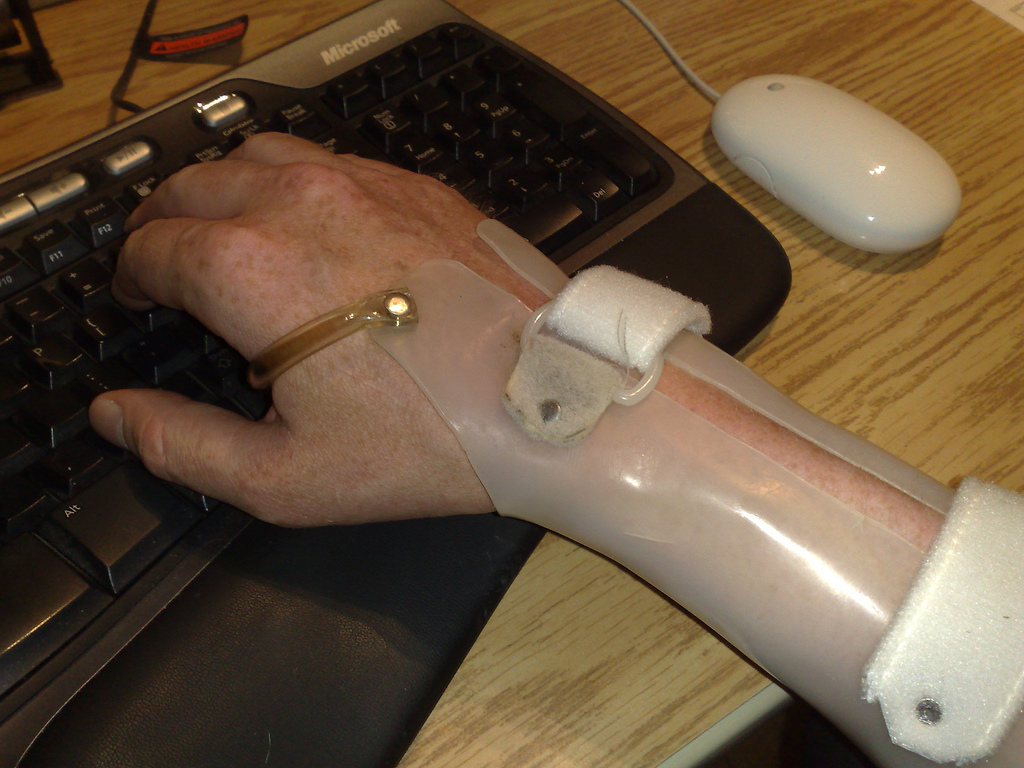
I’ve been using it to type with ever since, and it’s what has made the intervening years of my career as a professional keyboardist possible.
I’ve been back to the QEH a few times for tune-ups on the brace, but finally, after 16 years, it’s starting to wear out – the back velcro gave out a few months back, there’s a crack near the front – and I decided it was a good idea to find a replacement before it finally gave out completely lest I be unable to work at all.
Which led me to Barry MacKinnon at Island Orthotics this morning. Barry took a look at my brace, decided he could keep it working for a while longer but that he could also make me a new one (the snazzy new Velcro you see in the photo above was put on today). And so I was ushered into a side-room and after a few minutes of work my right arm looked like this:
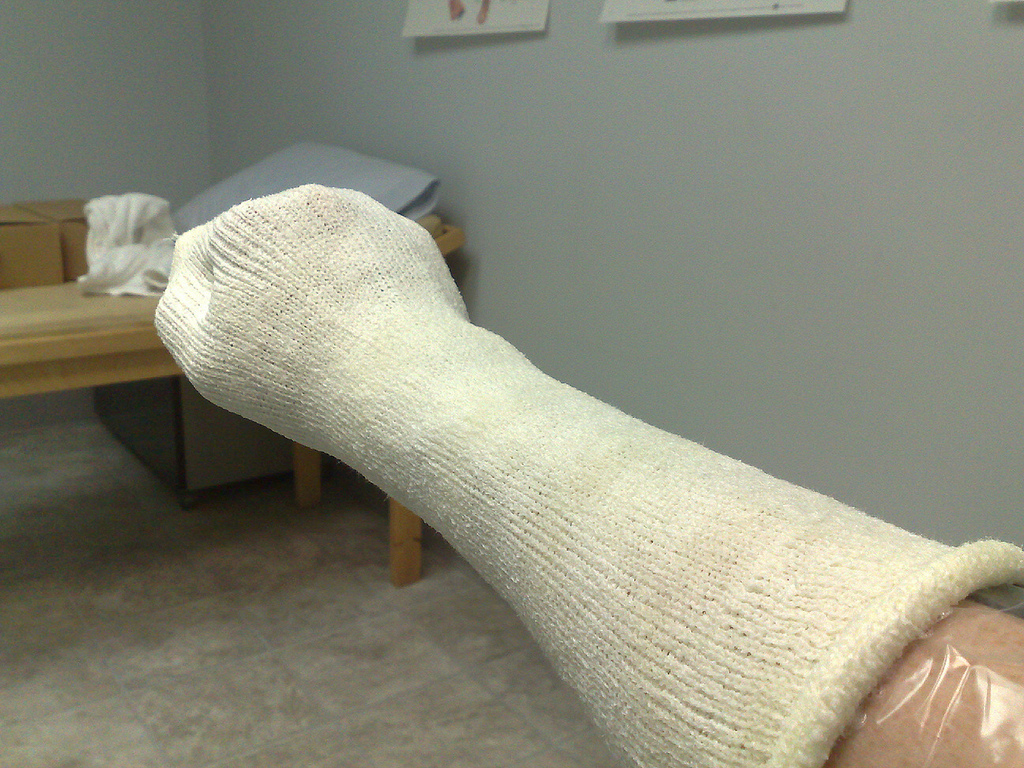
In a week or so I’ll return to pick up my new brace, meaning that my career can continue should I accidentally melt or otherwise destroy my trusty long-time wrist companion.
Barry has a fascinating shop in the basement of the Polyclinic on Grafton Street, filled with grinders and benders and melters and all other manner of machinery that allows him and his staff to make everything from wrist braces to replacement limbs.
 I am
I am